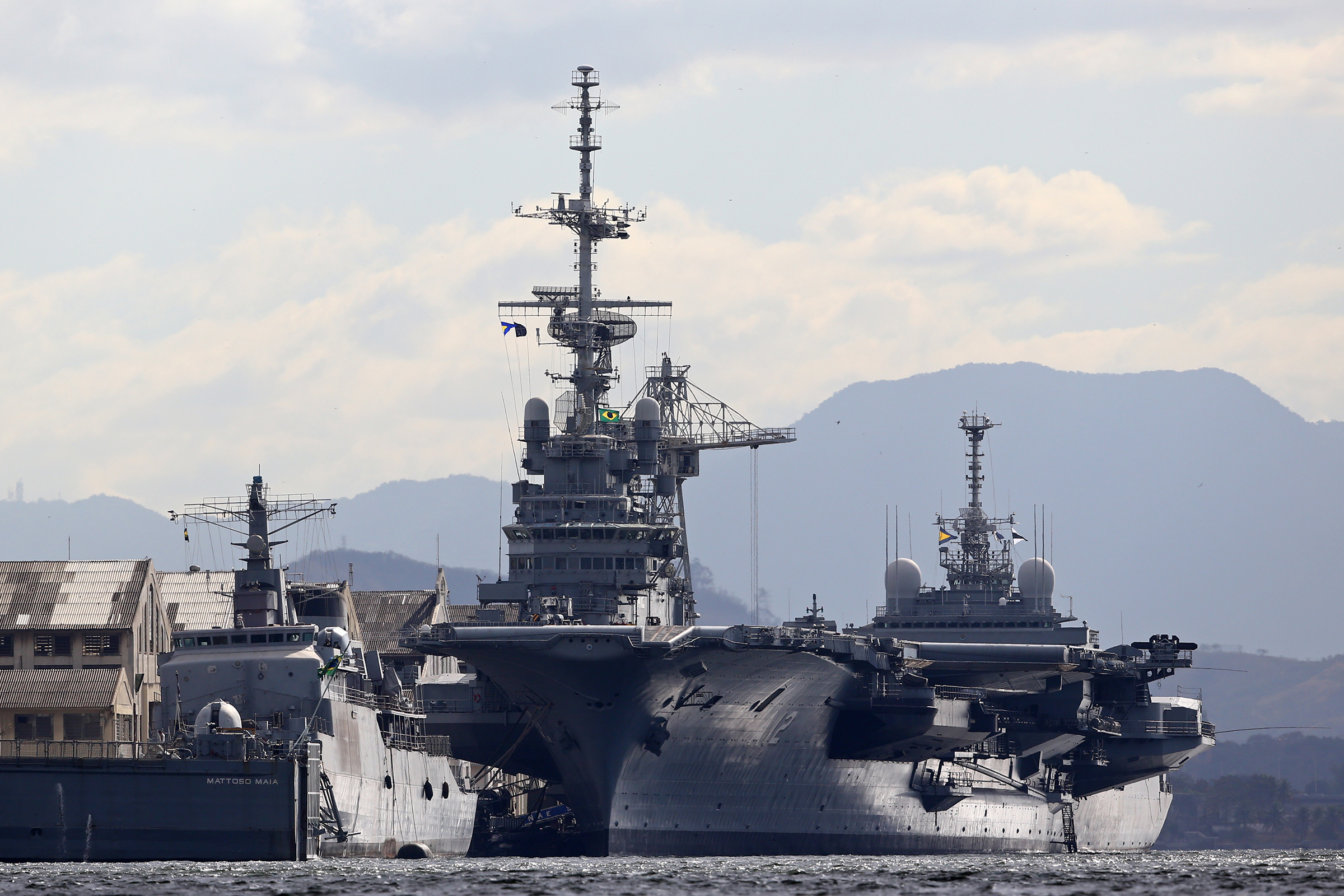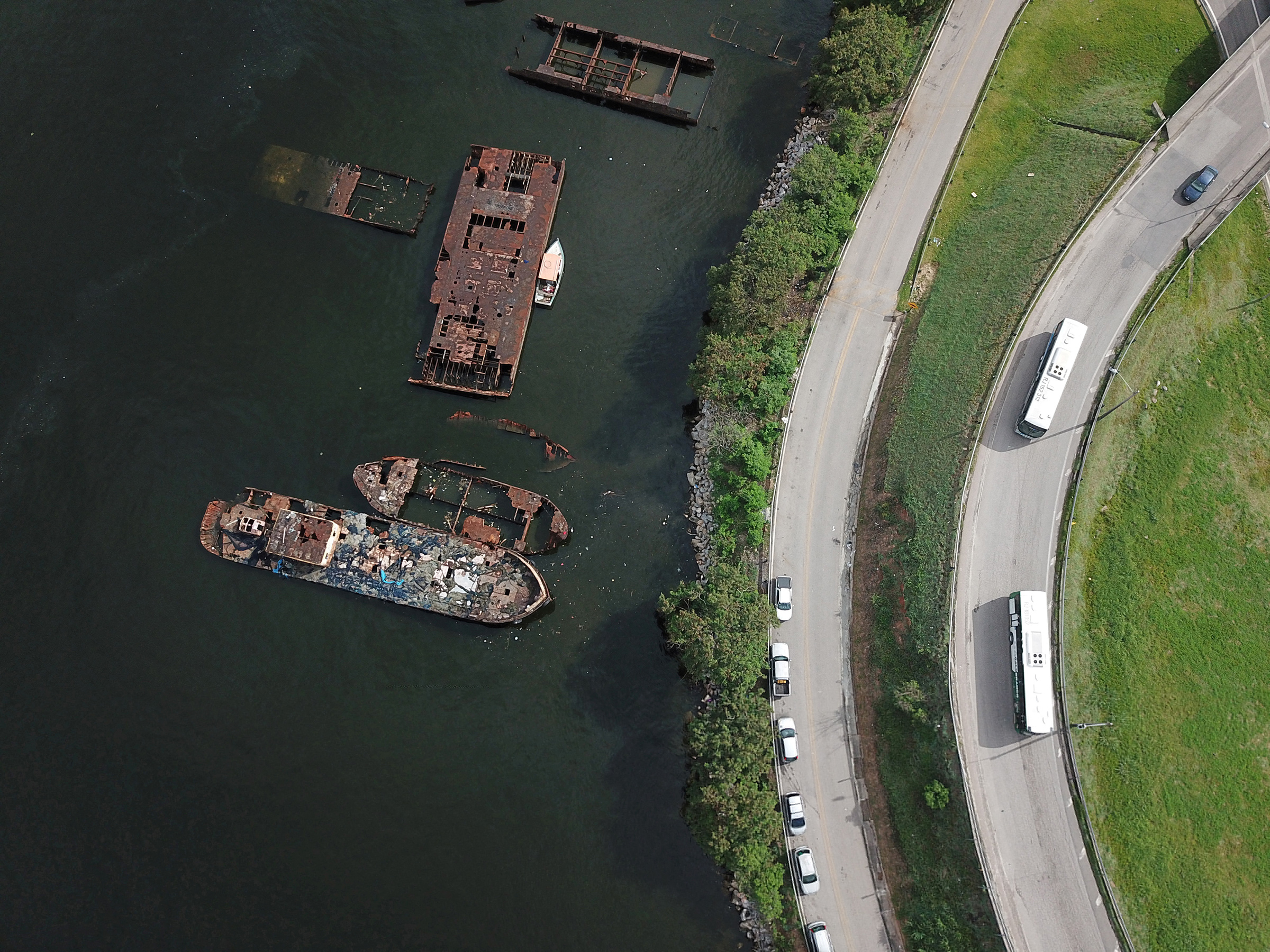
Somewhere in the South Atlantic ocean right now, a 34,000-ton, 870-ft. aircraft carrier is floating aimlessly on the waves. The vessel, caught in an international dispute over its toxic contents, is about to become one of the biggest pieces of trash in the ocean.
The São Paulo, the only aircraft carrier in the Brazilian navy’s fleet, has been stuck in limbo for five months. Brazil sold the 60-year-old vessel for scrap to a Turkish shipyard in 2021, and in August 2022, it set off for Turkey from a naval base in Rio de Janeiro. But while it was on the move, Turkey rescinded its permission to enter, saying Brazil hadn’t been able to prove that the São Paulo was free of asbestos—a toxic mineral used in the construction of many 20th century ships. So, the boat turned around.
Brazil doesn’t want it back, though. In September, a port on the coast of Pernambuco state blocked the ship from docking. The port argued there was too big a risk that the ship would be abandoned, leaving port authorities to pick up the tab for moving it and dealing with the asbestos. That left the São Paulo circling off the Brazilian coast, until Jan. 20, when Brazil’s navy announced that it had pushed the ship out to international waters, where it remains. The navy says it had to do so because the aging ship, which incurred damage to its hull during its odyssey, could have run aground or sank on the Brazilian coast, threatening other boats and coastal wildlife.
The navy’s solution is to abandon the São Paulo at sea. On Saturday, military sources told Brazil’s Folha de São Paulo newspaper that the navy planned to use explosive to sink the vessel on Wednesday, seeing it as the only way to put an end to its controversial saga.
But on Tuesday night, responding to concerns from a federal environmental agency, Brazil’s public prosecutor filed a civil case against the navy, asking a federal court to order an immediate halt to any plans to detonate the ship.
The court’s decision will determine whether or not the São Paulo becomes an extreme case of vessel abandonment—a problem that plagues marine conservationists and coastal communities around the world. Ocean watchdogs say sinking a boat as big and old as the São Paulo would be an environmental disaster; as well as the asbestos, the ship contains hundreds of metric tons of other toxic substances in its electrical wiring, paints, and fuel stores, according to the Basel Action Network (BAN), an NGO.
Abandoning it at sea would constitute “gross negligence” and violate three separate international environmental conventions, says Jim Puckett, BAN’s executive director. “We’re talking about a ship containing both hazardous materials and valuable materials—it’s supposed to be brought into the territory of Brazil and managed in an environmentally sound way,” Puckett says. “You can’t just sink it.”
Approached for comment, the Brazilian navy directed TIME to its official announcements, which say only that the navy will not allow the São Paulo to return to Brazil.

It’s not uncommon for boats to be abandoned. Because they are expensive to maintain and to dispose of properly, tens of thousands of unwanted vessels—normally much smaller than an aircraft carrier—are left in harbors, on beaches, or at sea every year. In Nigeria, thousands of wrecked cargo ships and commercial fishing vessels litter the coast, destroying beach ecosystems and making waterways dangerous to pass for local communities. In Venice, around 2,000 abandoned small recreational boats are clogging up a local wetland. In the U.S., the Government Accountability Office estimates that from 2013 to 2016, there were 5,600 boats abandoned in U.S. waters—likely a very lowball estimate, according to Nancy Wallace, director of the National Oceanic and Atmospheric Administration’s marine debris program.
The problem is, what’s left onboard those boats doesn’t stay onboard. “Anytime there’s a vessel that’s left at sea, the first thing to think about is toxic chemicals, which can be very impactful to wildlife,” Wallace says. Abandoned boats of any size can cause oil spills and leach paint chemicals and microplastics into the water, while debris such as nets can come loose, trapping fish.
Older vessels can also contain so-called PCBs, a group of highly carcinogenic chemicals that were often used in electrical wiring before the 1970s and were globally banned under the 2001 Stockholm convention. When dumped in the ocean, scientists say PCBs work their way up the marine food chain, affecting everything from small crustaceans to orcas. BAN estimates that the São Paulo, which was built in France in the 1960s, contains around 300 metric tons of PCBs, based on analysis of its sister ship, the Clemencau. The NGO says leaving the vessel at sea would violate both the Stockholm convention and the 1996 London Protocol.
In Brazil, the face of the ship abandonment problem is Guanabara Bay in Rio de Janeiro state, where some 200 vessels, including cargo ships and oil tankers, have been left to rot by owners caught up in financial or legal troubles. Local NGOs say the resulting oil and chemical pollution has dramatically reduced native mangrove, tortoise, and dolphin populations, and has hurt the livelihoods of local fishermen. The bay made national headlines in November, when a storm caused a 660-ft. cargo ship to come loose from its moorings and crash into the Rio-Niteroi—Latin America’s longest over-water bridge.

Removing such vessels is a major headache for governments. Hauling them out can cost anywhere from $8,000 (the per-boat cost for 14 recreational boats recently lifted out of the water in South Carolina) to $1.8 million (the cost for removing an 83-ft. fishing boat in Saipan in 2021, which had been degrading a nearby coral reef in the Northern Mariana Islands for six years after a 2015 storm left it too damaged for its owners to repair.)
But, thankfully, it is highly unusual for a ship as large as the São Paulo to be deliberately abandoned. That’s because large boats like cruise ships, container ships, and aircraft carriers contain vast amounts of high-quality valuable metals, especially steel, which can be salvaged and resold. (Recycling is also beneficial for the environment, since manufacturing new steel is extremely carbon-intensive.)
Puckett, from BAN, says the idea of sinking the São Paulo doesn’t make financial sense for Brazil. “It’s got millions of dollars worth of steel to be recycled, which far outweighs the cost of managing those hazardous materials,” he says. “I’ve never seen such a valuable ship being deliberately sunk.”
BAN is calling on Brazil’s new leftist President Luiz Inácio Lula da Silva to step in. To comply with international treaties, including the Basel Convention restricting the export of toxic waste, Puckett says the navy must tow the São Paulo into a naval base, repair the damage to the hull, and then offer the recycling contract to new shipyards in Europe, which can safely remove the asbestos before dismantling the ship.
The case brought by Brazil’s public prosecutor’s office opens a last minute door to that happening. It asks the court to compel the navy to carry out a technical assessment of all the options for disposing of the ship, and find a way of doing so “”without risk to the environment and public health.” That might just save the São Paulo from a toxic watery grave.
More Must-Reads from TIME
- Cybersecurity Experts Are Sounding the Alarm on DOGE
- Meet the 2025 Women of the Year
- The Harsh Truth About Disability Inclusion
- Why Do More Young Adults Have Cancer?
- Colman Domingo Leads With Radical Love
- How to Get Better at Doing Things Alone
- Michelle Zauner Stares Down the Darkness
Write to Ciara Nugent at ciara.nugent@time.com